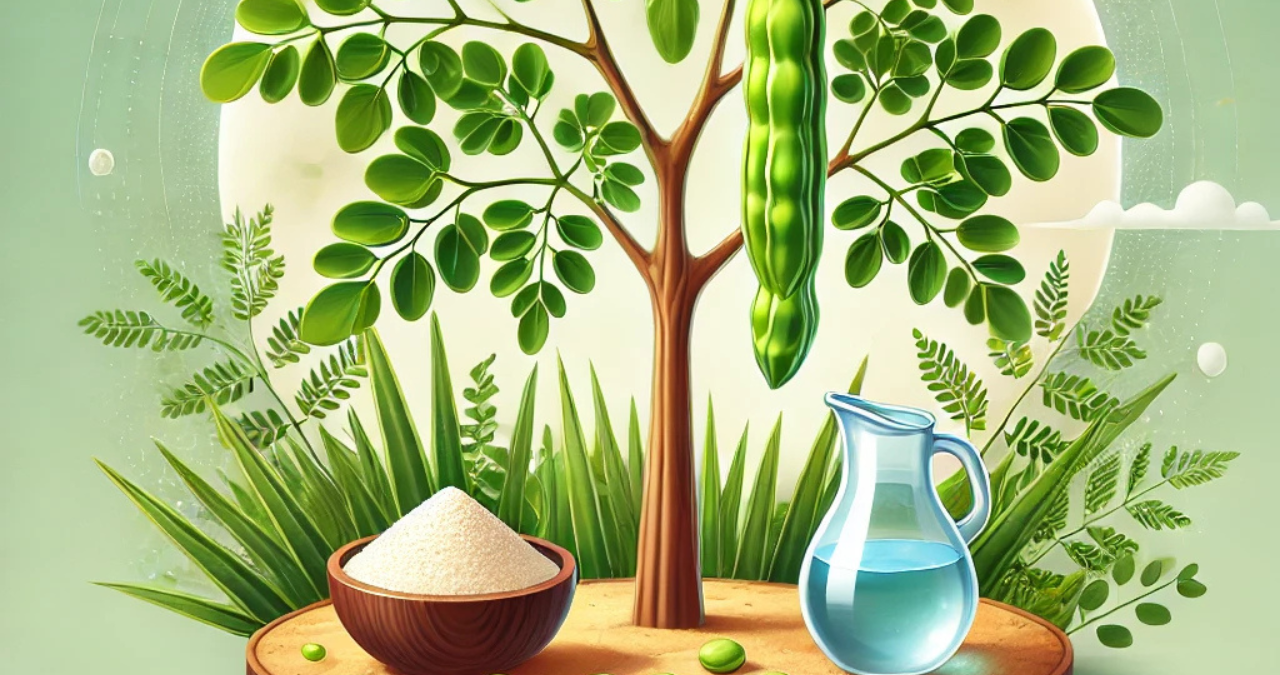Introduction
The moringa tree, often referred to as the “Drumstick Tree,” “Miracle Tree,” or “Tree of Life,” is one of nature’s most remarkable gifts. Native to the Indian subcontinent but now cultivated in tropical and subtropical regions worldwide, this hardy plant is celebrated for its incredible versatility and wide-ranging benefits. Every part of the moringa tree offers value to humans and the planet, from its nutrient-packed leaves to its water-purifying seeds.
Historically, moringa has been a cornerstone of traditional medicine and nutrition, revered for its ability to combat malnutrition and treat various ailments. Modern science has validated many of these claims in recent years, sparking a global interest in this extraordinary plant. This article delves into the numerous benefits of the moringa tree, its role in sustainable development, and how individuals can incorporate it into their lives.
What is the Moringa Tree?
The moringa tree, scientifically known as Moringa oleifera, belongs to the family Moringaceae. This fast-growing, drought-resistant tree thrives in various climates, from arid deserts to humid tropics. It is commonly found in countries like India, the Philippines, and parts of Africa, where it has been an essential part of local diets and traditional medicine for centuries.
The Versatile Parts of Moringa
Every part of the moringa tree serves a purpose. The leaves are rich in vitamins and minerals and are often consumed fresh, dried, or powdered. The pods, also known as drumsticks, are a staple in many cuisines. Moringa seeds yield a highly nutritious oil and can purify water, while the roots and bark have medicinal applications. This multifunctionality has earned the moringa the title of “Miracle Tree.”
Growth and Cultivation
Moringa’s adaptability makes it an ideal crop for areas prone to extreme weather conditions. It thrives in poor soils and requires minimal maintenance, making it accessible to small-scale farmers. Its rapid growth—reaching 10 feet within a year—ensures a steady supply of leaves and pods, even under challenging conditions.
Nutritional Powerhouse: The Health Benefits of Moringa
Moringa is often called a “superfood” due to its exceptional nutritional profile. It contains essential nutrients, including vitamins A, C, and E, calcium, potassium, iron, and protein. Additionally, moringa is rich in antioxidants like quercetin and chlorogenic acid, which help combat oxidative stress and inflammation.
Specific Health Benefits
Moringa leaves are renowned for boosting immunity, improving digestion, and supporting cardiovascular health. They are particularly beneficial for individuals with anaemia, as they provide a plant-based source of iron. Moringa’s anti-inflammatory properties effectively manage conditions like arthritis and asthma. Its antioxidant content also supports skin health, reducing the signs of ageing and promoting a natural glow.
Studies have shown that moringa can help regulate blood sugar levels for those managing diabetes, thanks to compounds that enhance insulin activity. Moreover, its high protein and fibre make it an excellent dietary addition for weight management and boosting energy.
Superfood Applications
Moringa can be incorporated into diets in various forms. Moringa powder, often added to smoothies or teas, provides a convenient way to enjoy its benefits. Fresh leaves can be used in salads or cooked as a vegetable, while the seeds and pods are popular in traditional dishes. Moringa oil is also gaining popularity as a nutrient-rich cooking oil and skincare ingredient.
Potential Risks and Side Effects
While moringa offers numerous health benefits, moderation is key. Excessive consumption may lead to digestive discomfort or interfere with certain medications. Pregnant women should avoid moringa roots and bark, as they may have uterine-stimulating properties. Consulting a healthcare provider before introducing moringa into one’s diet is advisable.
Environmental and Economic Importance
Beyond its nutritional value, the moringa tree plays a significant role in environmental sustainability and economic development. Its unique properties make it essential to combating climate change and supporting rural livelihoods.
Role in Combating Climate Change
Moringa trees contribute to environmental conservation by absorbing carbon dioxide and improving soil health. Their deep root systems prevent soil erosion, while their nitrogen-fixing abilities enrich the soil, making them a valuable companion crop. Additionally, moringa seeds can purify water by removing impurities and providing clean drinking water in resource-scarce areas.
Economic Opportunities
Moringa’s versatility extends to its economic potential. It is a cash crop for farmers, offering income by selling leaves, seeds, and oil. Processing industries that produce moringa-based products create employment opportunities, particularly in rural communities. Governments and NGOs increasingly promote moringa cultivation to alleviate poverty and improve food security.
Challenges in Scaling Production
Despite its benefits, moringa’s global adoption faces challenges, including limited awareness and logistical hurdles in processing and distribution. Addressing these issues through education and infrastructure development could unlock its full potential.
How to Grow and Use Moringa at Home

Growing moringa at home is a rewarding endeavour. Its low-maintenance nature makes it accessible to gardeners of all skill levels.
Step-by-Step Guide to Planting Moringa
- Seed Selection: Choose high-quality moringa seeds from a trusted source.
- Soil and Location: Plant in well-draining soil with ample sunlight.
- Planting: Sow seeds directly into the ground or start them in pots.
- Watering: Water regularly, but avoid overwatering, as moringa is drought-resistant.
Harvesting and Processing
Moringa leaves can be harvested as soon as the tree is well-established. For optimal nutritional value, dry the leaves in a shaded area and grind them into powder for storage. Pods can be picked when tender, while seeds are collected once mature.
DIY Uses
Homemade moringa tea is a popular way to enjoy its benefits. Moringa oil, extracted from seeds, can be used for cooking or as a moisturizer. Creative uses include incorporating moringa powder into baked goods or making nourishing hair masks.
Conclusion
The moringa tree embodies the best of nature’s offerings, providing a sustainable solution to global health, environmental, and economic challenges. Its nutritional richness, ecological benefits, and economic potential make it a miracle tree. Moringa offers a practical and impactful way to enhance health and contribute to a sustainable future, whether grown at home or purchased as powders, oils, or teas.
FAQs
- What makes the moringa tree a “superfood”?
- Its high levels of vitamins, minerals, and antioxidants make it exceptionally nutritious.
- Can anyone grow a moringa tree at home?
- Yes, moringa is easy to grow in well-drained soil and sunny conditions.
- Are there any side effects of consuming moringa?
- Overconsumption may cause digestive discomfort or interact with medications. Consult a healthcare provider.
- How does moringa contribute to environmental sustainability?
- It improves soil health, prevents erosion, and purifies water, making it a valuable ecological resource.
- What parts of the moringa tree are edible?
- Leaves, seeds, pods, and flowers are all edible and offer unique benefits.
You May Also Read: https://timebusinesswork.com/cecily-tynan-salary/

Leave a Reply